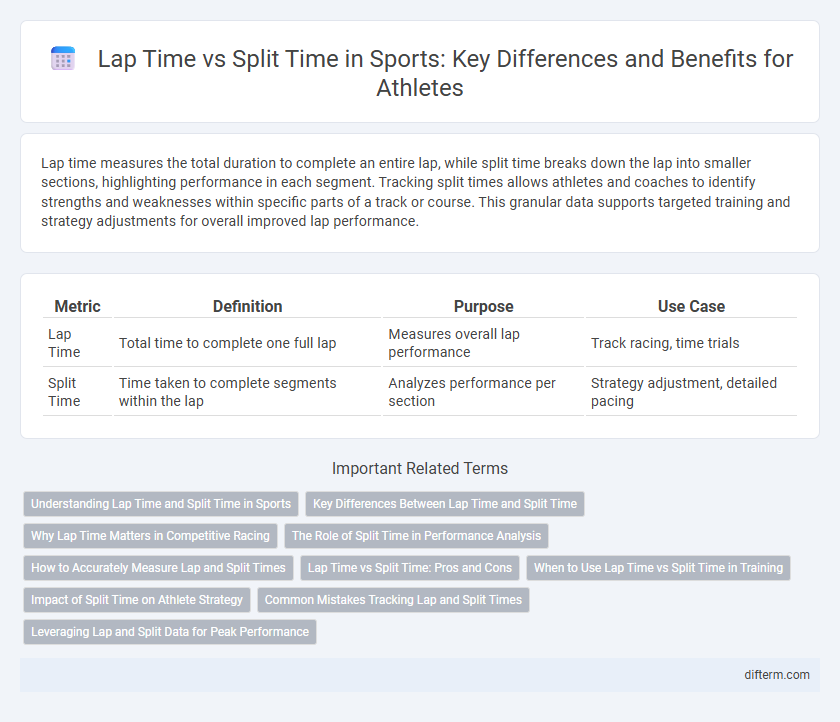Lap time measures the total duration to complete an entire lap, while split time breaks down the lap into smaller sections, highlighting performance in each segment. Tracking split times allows athletes and coaches to identify strengths and weaknesses within specific parts of a track or course. This granular data supports targeted training and strategy adjustments for overall improved lap performance.
Table of Comparison
| Metric | Definition | Purpose | Use Case |
|---|---|---|---|
| Lap Time | Total time to complete one full lap | Measures overall lap performance | Track racing, time trials |
| Split Time | Time taken to complete segments within the lap | Analyzes performance per section | Strategy adjustment, detailed pacing |
Understanding Lap Time and Split Time in Sports
Lap time measures the total duration taken to complete a full circuit or round in sports such as racing or swimming. Split time refers to the recorded duration for a specific segment or portion within the lap, providing detailed insights into performance variations. Analyzing both lap time and split time enables athletes and coaches to identify strengths, pinpoint weaknesses, and optimize race strategies for improved overall results.
Key Differences Between Lap Time and Split Time
Lap time measures the total duration taken to complete a full circuit or lap around a track, reflecting overall performance and pacing strategy. Split time, in contrast, records the elapsed time for specific segments or intervals within the lap, offering detailed insights into sections of the race like straights or corners. Understanding the key differences between lap and split times enables athletes and coaches to optimize training by identifying strengths and weaknesses in distinct parts of the track.
Why Lap Time Matters in Competitive Racing
Lap time measures the total duration to complete a full circuit, providing a comprehensive performance metric in competitive racing. Split time breaks down the lap into sections, highlighting specific areas for improvement, but the overall lap time determines race position and strategy effectiveness. Teams prioritize reducing lap time to gain a competitive edge, influencing tire management, fuel strategy, and driver consistency.
The Role of Split Time in Performance Analysis
Split time plays a crucial role in performance analysis by breaking down a lap into smaller segments, allowing athletes and coaches to identify strengths and weaknesses in specific sections of the track. Detailed split time data helps optimize pacing strategies and improve technique for targeted areas, enhancing overall lap times. Accurate split measurements provide insight into consistency and endurance, which are key factors in competitive sports performance.
How to Accurately Measure Lap and Split Times
Accurately measuring lap and split times requires high-precision timing systems such as RFID transponders or photoelectric sensors placed at key points on the track. Lap times capture the total duration for completing a full circuit, while split times measure sections within the lap, providing granular data for performance analysis. Consistent sensor calibration and timing synchronization are essential to ensure measurement accuracy and reliable athlete performance tracking.
Lap Time vs Split Time: Pros and Cons
Lap time measures the total duration to complete an entire circuit, providing a comprehensive performance overview, while split time breaks down the lap into segments, allowing for detailed analysis of specific sections. Using lap time helps identify overall consistency and endurance, whereas split time highlights strengths and weaknesses within individual parts of the track. Combining both metrics enables athletes and coaches to pinpoint areas for improvement and optimize race strategies effectively.
When to Use Lap Time vs Split Time in Training
Lap time measures the total duration to complete an entire circuit, essential for evaluating overall performance and consistency during training sessions. Split time captures intermediate segments within the lap, providing detailed insight into pacing, technique, and specific areas needing improvement. Use lap time to assess endurance and race strategy, while split time targets refining technique and optimizing individual segments for enhanced performance.
Impact of Split Time on Athlete Strategy
Split time analysis enables athletes to fine-tune pacing strategies by identifying strengths and weaknesses during specific sections of a race, leading to more efficient energy distribution. Precise monitoring of split times helps optimize training regimens and race-day decisions by highlighting intervals where performance can improve. Effective use of split time data directly influences lap time reduction, enhancing overall competitive outcomes.
Common Mistakes Tracking Lap and Split Times
Confusing lap time with split time is a common mistake that skews performance analysis in sports timing. Lap time measures the duration of a complete circuit or segment of a course, while split time records intermediate segments within a lap, providing detailed progress checkpoints. Accurate tracking requires distinguishing these metrics to avoid errors in racing strategy and athlete evaluation.
Leveraging Lap and Split Data for Peak Performance
Analyzing lap time and split time data allows athletes and coaches to pinpoint performance variations throughout a race, identifying strengths and weaknesses in specific sections. Leveraging this detailed timing information aids in optimizing pacing strategies, improving consistency, and targeting targeted training interventions. Effective use of lap and split metrics drives measurable improvements in overall race outcomes and peak athletic performance.
lap time vs split time Infographic

 difterm.com
difterm.com